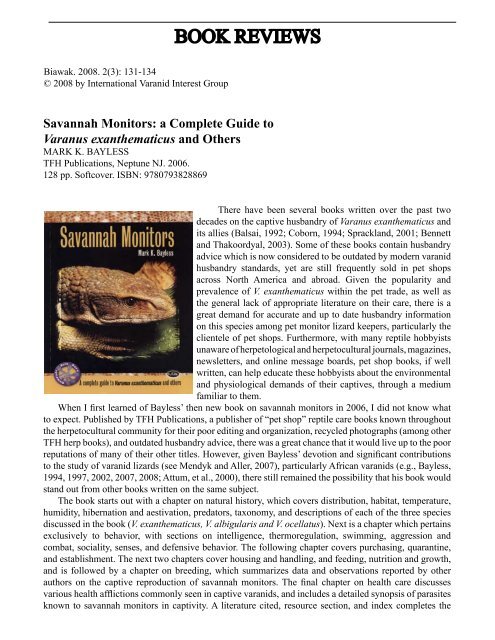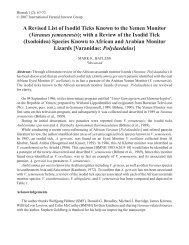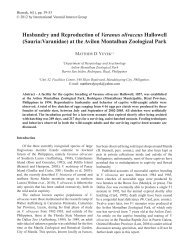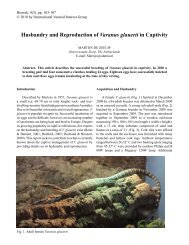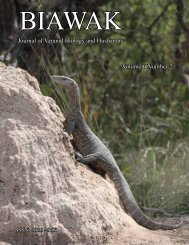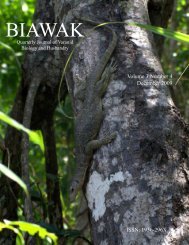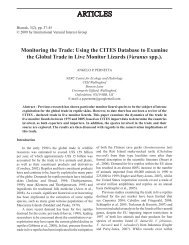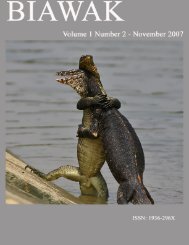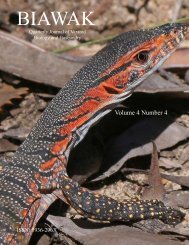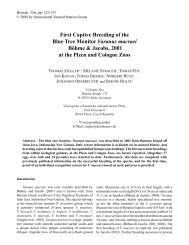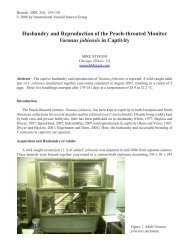BOOK REVIEWSBiawak. 2008. 2(3): 131-134© 2008 by <strong>International</strong> <strong>Varanid</strong> <strong>Interest</strong> <strong>Group</strong>Savannah Monitors: a Complete Guide toVaranus exanthematicus and OthersMARK K. BAYLESSTFH Publications, Neptune NJ. 2006.128 pp. Softcover. ISBN: 9780793828869There have been several books written over the past twodecades on the captive husbandry of Varanus exanthematicus andits allies (Balsai, 1992; Coborn, 1994; Sprackland, 2001; Bennettand Thakoordyal, 2003). Some of these books contain husbandryadvice which is now considered to be outdated by modern varanidhusbandry standards, yet are still frequently sold in pet shopsacross North America and abroad. Given the popularity andprevalence of V. exanthematicus within the pet trade, as well asthe general lack of appropriate literature on their care, there is agreat demand for accurate and up to date husbandry informationon this species among pet monitor lizard keepers, particularly theclientele of pet shops. Furthermore, with many reptile hobbyistsunaware of herpetological and herpetocultural journals, magazines,newsletters, and online message boards, pet shop books, if wellwritten, can help educate these hobbyists about the environmentaland physiological demands of their captives, through a mediumfamiliar to them.When I first learned of Bayless’ then new book on savannah monitors in 2006, I did not know whatto expect. Published by TFH Publications, a publisher of “pet shop” reptile care books known throughoutthe herpetocultural community for their poor editing and organization, recycled photographs (among otherTFH herp books), and outdated husbandry advice, there was a great chance that it would live up to the poorreputations of many of their other titles. However, given Bayless’ devotion and significant contributionsto the study of varanid lizards (see Mendyk and Aller, 2007), particularly African varanids (e.g., Bayless,1994, 1997, 2002, 2007, 2008; Attum, et al., 2000), there still remained the possibility that his book wouldstand out from other books written on the same subject.The book starts out with a chapter on natural history, which covers distribution, habitat, temperature,humidity, hibernation and aestivation, predators, taxonomy, and descriptions of each of the three speciesdiscussed in the book (V. exanthematicus, V. albigularis and V. ocellatus). Next is a chapter which pertainsexclusively to behavior, with sections on intelligence, thermoregulation, swimming, aggression andcombat, sociality, senses, and defensive behavior. The following chapter covers purchasing, quarantine,and establishment. The next two chapters cover housing and handling, and feeding, nutrition and growth,and is followed by a chapter on breeding, which summarizes data and observations reported by otherauthors on the captive reproduction of savannah monitors. The final chapter on health care discussesvarious health afflictions commonly seen in captive varanids, and includes a detailed synopsis of parasitesknown to savannah monitors in captivity. A literature cited, resource section, and index completes the
Biawak 2008 Vol. 2 No. 3132book.In many ways, this book is not unlike previous titles from TFH, having careless editing mistakesincluding missing text and awkward grammar. A notable example of careless editing occurs halfway throughthe description of V. ocellatus in the first chapter, where the text is cut off after page 23, and immediatelyskips to the next chapter. A noticeable inconsistency occurs in the third chapter, on purchasing a monitor.With the exception of the first section of the chapter entitled “Monitor Addiction”, all successive parts tothis chapter are inconsistent with Bayless’ writing style, and appear to have been written by someone else.This is not surprising, given that the vagueness, styling and formatting of this chapter could theoreticallybe used for other taxa; an interchangable “cookie-cutter” insert usable in multiple reptile hobbyist books.In fact, the writing style of this chapter is reminiscent of the typical formatting used in many other poorreptile keeping books of the past.Editorial blunders aside, there were a few sections which were disagreeable, or questionable intheir inclusion within the book. The section on taxonomy, which includes a table listing morphometricmeasurements and scale counts for each species, may be confusing or too complicated for the average pethobbyist to fully comprehend or even care about, especially when no comparative photographs of eachspecies are provided to accompany the section. To further add to this confusion, Bayless goes throughthe trouble of arguing the validity of V. ocellatus, a species long-synonymized with V. exanthematicus(Mertens, 1942), as well as its subtle differences from V. exanthematicus. Yet, not a single photo of V.ocellatus is provided in the book. Lastly, after a seemingly long-winded discussion about V. ocellatusand its taxonomic validity, the reader isn’t even given the opportunity to completely review the evidenceprovided by Bayless for its alleged validity, because that portion of the text was left out by carelessediting!A few anecdotal reports of sociality, varanid senses, and “looping behavior” add little or nothing to thisbook, but were perhaps included to catch or maintain the interest of readers. I felt that the section on clawtrimming was inappropriate and potentially misleading especially to beginner hobbyists, considering thatvaranid lizards do not require nail trimmings if their environmental needs are met. Encouraging hobbyiststo do so may just further reinforce the anthropomorphic mindset already prevalent among many keeperswhich often hinders progressive and critical thinking towards the improvement of their reptile husbandry.Lastly, my final criticism pertains to the chapter on health care. Lacking were descriptions of appropriatetreatments for the ailments described. However, I suppose one can argue that given the target audience ofthis book, it is probably best that beginner hobbyists do not attempt to perform veterinary procedures andtreatments on their own.Despite the many shortcomings of this book, there were a few positive aspects which stood out overseveral other published books on savannah monitors. It was encouraging to see a section devoted todefensive behavior rather than “aggressiveness”, as it is so commonly misrepresented to describe captivevaranid behavior. Bayless discusses the fear and vulnerability which hatchling and recently-importedindividuals experience in captivity, something which many beginner monitor keepers seldom understand.Addressing these issues may help reduce the amount of stress exerted on newly acquired monitor lizardsby unsuspecting, beginner keepers. Bayless also stresses the importance of variation in diet, advisingkeepers to offer an assortment of prey items, while stressing the importance of avoiding improper dietsperpetuated by the pet trade, such as dog food and canned monitor lizard diet. Improper diet is a majorcontributor to poor health and premature death in captive varanids. Addressing these important issues inhis book may help improve the current state of varanid husbandry among beginner hobbyists.Unlike many other pet reptile books I’ve come across over the years, Bayless actually cites primaryliterature within the text; something which I fear will go unnoticed and unutilized by the book’s targetbeginner audience. It was quite surprising to see references cited throughout this book, as it would seemthat for such a non-technical book, a literature cited section would be a considerable waste of valuable


